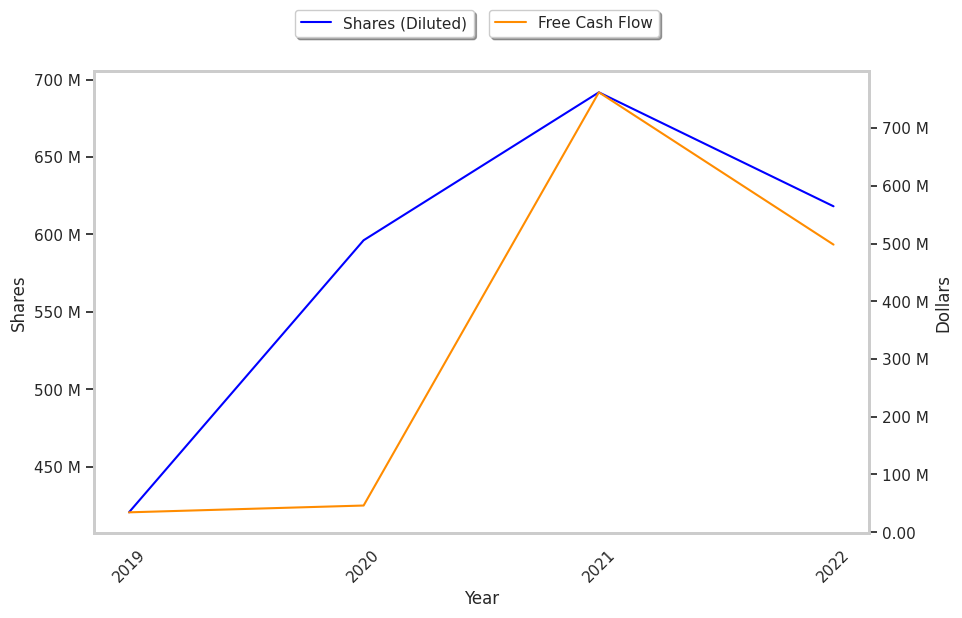Software company Pinterest stunned Wall Street today as it plummeted to $26.73, marking a -3.7% change compared to the S&P 500 and the Nasdaq indices, which logged -1.0% and -1.0% respectively. PINS is -18.73% below its average analyst target price of $32.89, which implies there is more upside for the stock.
As such, the average analyst rates it at buy. Over the last year, Pinterest shares have outperformed the S&P 500 by 3.0%, with a price change of 25.0%.
Pinterest, Inc. operates as a visual discovery engine in the United States and internationally. The company is a technology company. Valuations in the technology sector are often very high, as investors are willing to overlook gaps in the fundamentals if they believe a company’s innovations can dominate or create new markets.
Pinterest does not release its trailing 12 month P/E ratio since its earnings per share of $-0.42 are negative over the last year. But we can calculate it ourselves, which gives us a trailing P/E ratio for PINS of -63.6. Based on the company's positive earnings guidance of $1.19, the stock has a forward P/E ratio of 22.5. As of the first quarter of 2023, the average Price to Earnings (P/E) ratio of US technology companies is 27.16, and the S&P 500 average is 15.97. The P/E ratio consists in the stock's share price divided by its earnings per share (EPS), representing how much investors are willing to spend for each dollar of the company's earnings. Earnings are the company's revenues minus the cost of goods sold, overhead, and taxes.
We can take the price to earnings analysis one step further by dividing the P/E ratio by the company’s projected five-year growth rate, which gives us its Price to Earnings Growth, or PEG ratio. This ratio is important because it allows us to identify companies that have a low price to earnings ratio because of low growth expectations, or conversely, companies with high P/E ratios because growth is expected to take off.
Pinterest's PEG ratio of 1.1 indicates that its P/E ratio is fair compared to its projected earnings growth. In other words, the company’s valuation accurately reflects its estimated growth potential. The caveat, however, is that these growth estimates could turn out to be inaccurate.
To better understand the strength of Pinterest's business, we can analyse its operating margins, which are its revenues minues its operating costs. Consistently strong margins backed by a positive trend can signal that a company is on track to deliver returns for its shareholders. Here's the operating margin statistics for the last four years:
| Date Reported | Total Revenue ($ k) | Operating Expenses ($ k) | Operating Margins (%) | YoY Growth (%) |
|---|---|---|---|---|
| 2023-02-06 | 2,802,574 | -2,225,654 | -4 | -130.77 |
| 2022-02-03 | 2,578,027 | -1,722,520 | 13 | 262.5 |
| 2021-02-05 | 1,692,658 | -1,385,804 | -8 | 93.44 |
| 2020-02-07 | 1,142,761 | -2,172,724 | -122 |
- Average operating margins: -30.2%
- Average operating margins growth rate: 58.5%
- Coefficient of variability (lower numbers indicate less volatility): 204.4%
Another key to assessing a company's health is to look at its free cash flow, which is calculated on the basis of its total cash flow from operating activities minus its capital expenditures. Capital expenditures are the costs of maintaining fixed assets such as land, buildings, and equipment. From Pinterest's last four annual reports, we are able to obtain the following rundown of its free cash flow:
| Date Reported | Cash Flow from Operations ($ k) | Capital expenditures ($ k) | Free Cash Flow ($ k) | YoY Growth (%) |
|---|---|---|---|---|
| 2023-02-06 | 469,202 | -28,984 | 498,186 | -34.62 |
| 2022-02-03 | 752,907 | -9,031 | 761,938 | 1548.25 |
| 2021-02-05 | 28,826 | -17,401 | 46,227 | 34.22 |
| 2020-02-07 | 657 | -33,783 | 34,440 |
- Average free cash flow: $335.2 Million
- Average free cash flow growth rate: 0.0%
- Coefficient of variability (the lower the better): 92291346.6%
Free cash flows represents the amount of money that is available for reinvesting in the business, or paying out to investors in the form of a dividend. With a positive cash flow as of the last fiscal year, PINS is in a position to do either -- which can encourage more investors to place their capital in the company.
Another valuation metric for analyzing a stock is its Price to Book (P/B) Ratio, which consists in its share price divided by its book value per share. The book value refers to the present liquidation value of the company, as if it sold all of its assets and paid off all debts. As of the first quarter of 2023, the average P/B ratio for technology companies is 6.23. In contrast, the average P/B ratio of the S&P 500 is 2.95. Pinterest's P/B ratio indicates that the market value of the company exceeds its book value by a factor of 6, so it's likely that equity investors are over-valuing the company's assets.
As of first quarter of 2023, Pinterest is likely overvalued because it has a negative P/E ratio, an average P/B ratio, and irregular cash flows with a flat trend. The stock has poor growth indicators because of its consistently negative margins with a positive growth rate, and a negative PEG ratio. We hope this analysis will inspire you to do your own research into PINS's fundamental values -- especially their trends over time.



